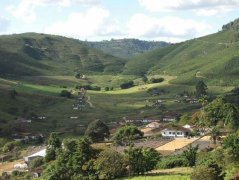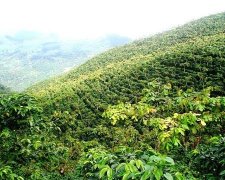China's most suitable microclimate for coffee cultivation Introduction to coffee cultivation on the environmental needs
China's most suitable microclimate for coffee cultivation Introduction to coffee cultivation on the environmental needs

The coffee tree is native to Ethiopia in Africa. Coffee tree in botany, belongs to the Rubiaceae coffee subgenus evergreen tree, and generally known as coffee beans, survey is the coffee tree fruit seeds, only because the shape like beans, so called coffee beans.
Climate is the decisive factor for coffee cultivation. Coffee trees are only suitable for growing in the tropics or subtropics, so the zone between north and south latitudes is most suitable for coffee cultivation. This coffee-producing zone is commonly referred to as the "coffee belt" or "coffee zone."
However, not all the land in this area can produce good coffee trees. The ideal planting conditions for coffee trees are warm climates with temperatures between 15-25 ° C and rainfall of 1500-2000 mm throughout the year, and the rainfall time should match the flowering cycle of coffee trees. Of course, in addition to seasonal and rainfall coordination, there must be fertile soil. The soil most suitable for coffee cultivation is fertile, well drained soil containing pozzolanic matter.
Coffee belt: coffee can not be grown in any environment, because it is originally a tropical rainforest environment of plants, in the development of the system, the need for calm wind, warm, shade or semi-shade and humid environment habits.
Temperature: The requirements for temperature vary with the cultivated species, small species are more cold-resistant, like warm and cool climate, requiring an average annual temperature of 19~21 degrees.
Rainfall: annual rainfall of more than 1250 mm, evenly distributed, especially in flowering and small fruit development period, there is a certain amount of rainfall most suitable for coffee growth and development.
Light: coffee trees do not tolerate strong light, need appropriate shade, light is too strong, growth is inhibited. If water and fertilizer are insufficient, premature aging and even death will occur. Excessive shade, long foliage, few flowers and fruits, low yield.
Wind: Coffee likes a calm environment.
Soil: coffee tree root system developed, absorption root distribution shallow, loose requirements, fertile, good drainage loam.
Most coffee harvesting in the world is done by hand, so harvesting coffee is a labour-intensive and seasonally intensive process. Since both flowers and fruits are present on the same branch, the picker's index finger and thumb are the best tools for gathering ripe berries. Ripe berries cannot be distinguished from green berries either by scraping them off the entire branch by hand or by using automated harvesting machines.
Coffee farmers who produce low-grade coffee beans prefer to harvest the beans in a labor-saving way, but this reduces the coffee's flavor and grade because of its impure quality. In some parts of Africa, coffee beans are picked by shaking the coffee tree, shaking the fruit off the ground and picking it up before it hurts and rots. Most of Brazil produces secondary coffee, which is harvested by plucking all the leaves, flowers, overheated and green fruit from the branches at once. It takes two years for the damaged coffee trees to recover.
Important Notice :
前街咖啡 FrontStreet Coffee has moved to new addredd:
FrontStreet Coffee Address: 315,Donghua East Road,GuangZhou
Tel:020 38364473
- Prev

How to grow Coffee quality will be better Coffee planting Micro-environment introduction
How to grow coffee quality will be better coffee planting microenvironment introduces the origin of coffee trees in Ethiopia, Africa. In botany, coffee trees belong to the evergreen trees of the subgenus Rubiaceae, and coffee beans, commonly known as coffee beans, are the seeds of the fruit of coffee trees, just because they are shaped like beans, so they are called coffee beans. Climate is the decision of coffee cultivation.
- Next

How does each producing area pick coffee cherry coffee as long as it is planted in the coffee belt?
How do each producing area pick coffee cherry coffee as long as it is planted in the coffee belt? the origin of the coffee tree is Ethiopia in Africa. In botany, coffee trees belong to the evergreen trees of the subgenus Rubiaceae, and coffee beans, commonly known as coffee beans, are the seeds of the fruit of coffee trees, just because they are shaped like beans, so they are called coffee beans. The climate is coffee.
Related
- Beginners will see the "Coffee pull flower" guide!
- What is the difference between ice blog purified milk and ordinary milk coffee?
- Why is the Philippines the largest producer of crops in Liberia?
- For coffee extraction, should the fine powder be retained?
- How does extracted espresso fill pressed powder? How much strength does it take to press the powder?
- How to make jasmine cold extract coffee? Is the jasmine + latte good?
- Will this little toy really make the coffee taste better? How does Lily Drip affect coffee extraction?
- Will the action of slapping the filter cup also affect coffee extraction?
- What's the difference between powder-to-water ratio and powder-to-liquid ratio?
- What is the Ethiopian local species? What does it have to do with Heirloom native species?

